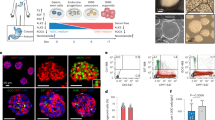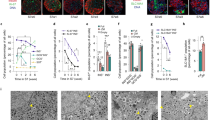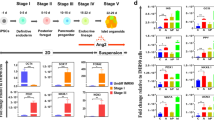Abstract
Ductal structures of the adult pancreas contain stem cells that differentiate into islets of Langerhans. Here, we grew pancreatic ductal epithelial cells isolated from prediabetic adult non-obese diabetic mice in long-term cultures, where they were induced to produce functioning islets containing α, β and δ cells. These in vitro-generated islets showed temporal changes in mRNA transcripts for islet cell-associated differentiation markers, responded in vitro to glucose challenge, and reversed insulin-dependent diabetes after being implanted into diabetic non-obese diabetic mice. The ability to control growth and differentiation of islet stem cells provides an abundant islet source for β-cell reconstitution in type I diabetes.
This is a preview of subscription content, access via your institution
Access options
Subscribe to this journal
Receive 12 print issues and online access
$209.00 per year
only $17.42 per issue
Buy this article
- Purchase on Springer Link
- Instant access to full article PDF
Prices may be subject to local taxes which are calculated during checkout






Similar content being viewed by others
References
Lacy, P.E. & Davies, J. Preliminary studies on the demonstration of insulin in the islets by fluorescent antibody technique. Diabetes 6, 354–357 ( 1957).
Baum, J., Simons, B.E., Unger, R.H. & Madison, L.L. Localization of glucagon in the alpha cells in the pancreatic islet by immunofluorescent technics. Diabetes 11, 371– 374 (1962).
Dubois, M.P. Immunoreactive somatostatin is present in discrete cells of the endocrine pancreas. Proc. Natl. Acad. Sci. USA 72, 1340–1343 (1975).
Pelletier, G., Leclerc, R., Arimura, A. & Schally, A.V. Immunohistochemical localization of somatostatin in rat pancreas. J. Histochem. Cytochem. 23, 699–701 ( 1975).
Larsson, L.I., Sundler, F. & Hakanson, R. Immunohistochemical localization of human pancreatic polypeptide (HPP) to a population of islet cells. Cell Tissue Res. 156, 167–171 ( 1975).
Brelje, T.C., Scharp, D.W. & Sorenson, R.L. Three-dimensional imaging of intact isolated islets of Langerhans with confocal microscopy. Diabetes 38 , 808–814 (1989).
Pictet, R.L. & Rutter, W.J. in Handbook of Physiology (eds. Steiner, D. & Frienkel, N.) 25–66 (Williams & Wilkins, Baltimore, Maryland, 1972).
Slack, J.M.W. Developmental biology of the pancreas. Development 121, 1569–1580 (1995).
Bonner-Weir, S. & Smith, F.E. Islet cell growth and the growth factors involved. Trends Endocrinol. Metab. 5, 60–64 (1994).
Weaver, C.V., Sorenson, R.L. & Kuang, H.C. Immunocytochemical localization of insulin- immunoreactive cells in the ducts of rats treated with trypsin inhibitor. Diabetologia 28, 781–785 ( 1985).
Bouwens, L. & Pipleers, D.G. Extra-insular beta cells associated with ductules are frequent in adult human pancreas. Diabetologia 41, 629–633 ( 1998).
Gu, D, Sarvetnick, N. Epithelial cell proliferation and islet neogenesis in IFN-γ transgenic mice. Development 118, 33–46 ( 1993).
Hellerstrom, C. The life story of the pancreatic B cell. Diabetologia 26, 393–400 (1984).
Swenne, I. Pancreatic beta-cell growth and diabetes mellitus. Diabetologia 35, 193–201 ( 1992).
Rosenberg, L. & Vinik, A.I. Trophic stimulation of the ductular-islet cell axis: a new approach to the treatment of diabetes. Adv. Exp. Med. Biol. 321, 95–104 ( 1992).
Rao, M.S., Dwivedi, R.S. & Yeldani, A.V. Role of periductal and ductal epithelial cells of the adult pancreas in pancreatic hepatocyte lineage. A change in the differentiation commitment. Am. J. Pathol. 134, 1069– 1086 (1989).
Weir, G.C. & Bonner-Weir, S. Islets of Langerhans: the puzzle of intraislet interactions and their relevance to diabetes. J. Clin. Invest. 85, 983–987 (1990).
Teitelman, G., Alpert, S., Polak, J.M., Martinez, A. & Hanahan, D. Precursor cells of mouse endocrine pancreas coexpress insulin, glucagon and the neuronal proteins tyrosine hydroxylase and neuropeptide Y, but not pancreatic polypeptide. Development 118, 1031–1039 (1993).
Bonner-Weir, S. & Orci, L. New perspectives on the microvasculature of the islets of Langerhans in the rat. Diabetes 41, 93–97 ( 1982).
Teitelman, G., Alpert, S. & Hanahan, D., Proliferation, senescence, and neoplastic progression of β cells in hyperplastic pancreatic islets. Cell 52, 97–105 (1988).
Menger, M.D., Vajkoczy, P., Beger, C. & Messmer, K. Orientation of microvascular blood flow in pancreatic islet isografts. J. Clin. Invest. 93, 2280–2285 ( 1994).
Eisenbarth, G.S. Type I diabetes mellitus, a chronic autoimmune disease. N. Engl. J. Med. 314, 1360–1368 ( 1986).
Wicker, L.S., Todd, J.A. & Peterson, L.B. Genetic control of autoimmune diabetes in the NOD mouse. Ann. Rev. Immunol. 13, 179– 200 (1995).
Leiter, E.H., Prochazka, M. & Coleman, D.L. Animal model of human disease, the non-obese diabetic (NOD) mouse. Am. J. Path. 128, 380– 383 (1987).
Vogel, G. Harnessing the power of stem cells. Science 283, 1468–1470 (1999).
Leary, T., Jones, P.L., Appleby, M., Blight, A., Parkinson, K. & Stanley, M. Epidermal keratinocyte self-renewal is dependent upon dermal integrity. J. Invest. Dermatol. 99, 422–430 (1992).
Ramrakha, P.S., Sharp, R.J., Yeoman, H. & Stanley, M.A. The influence of MHC-compatible and MHC-incompatible antigen-presenting cells on the survival of MHC-compatible cultured murine keratinocyte allografts. Transplantation 48, 676–680 ( 1989).
O'Connor, N.E., Mulliken, J.B., Banks-Schlegel, S., Kehinde, O. & Green, H. Grafting of burns with cultured epithelium prepared from autologous epidermal cells. Lancet I, 75–78 (1981).
Schofield, R. & Dexter, T.M. Studies on the self-renewal ability of CFU-S which have been serially transferred in long-term culture or in vivo. Leukaemia Res. 9, 305– 313 (1985).
Cornelius, J.G., Tchernev, V., Kao K-J. & Peck, A.B. In vitro generation of islets in long-term cultures of pluripotent stem cells from adult mouse pancreas. Horm. Metab. Res. 29, 271– 277 (1997).
Pittenger, M.F. et al. Multilineage potential of adult human mesenchymal stem cells . Science 284, 143–147 (1999).
Otonkoski, T., Beattie, G.M., Mally, M.I., Ricordi, C. & Hayek, A. Nicotinamide is a potent inducer of endocrine differentiation in cultured human fetal pancreatic cells. J. Clin. Invest. 92, 1459–1466 (1993).
Ohgawara, H. et al. Reversal of glucose insensitivity of pancreatic B-cells due to prolonged exposure to high glucose in culture: effect of nicotinamide on pancreatic B-cells. Tohoku J. Exp. Med. 169, 159–166 (1993).
Sener, A., Welsh, M., Welsh, N., Hellerstrom, C., Malaisse, W.J. Maturation of fetal rat islets in vitro during tissue culture is associated with increased mitochondrial function. Diabetes Research 13, 157–161 ( 1990).
Drucker, D.J., Philippe, J., Mojsor, S., Chick, W.L. & Habener, J.F. Glucagon like peptide-1 stimulates insulin gene expression and increased cyclic AMP levels in a rat islet cell line. Proc. Natl. Acad. Sci. USA 84, 3434–3438 (1987).
Beattie, G.M., Levine, F., Mally, M.I., Otonkoski, T., O'Brien, J.S., Salomon, D.R. & Hayek, A. Acid β-galactosidase: a developmentally regulated marker of endocrine cell precursors in the human fetal pancreas . J. Clin. Endo. Med. 78, 1232– 1240 (1994).
Rooman, I., Schuit, F. & Bouwens, L. Effect of vascular endothelial growth factor on growth and differentiation of pancreatic ductal epithelium. Lab. Invest. 76, 225–232 ( 1997).
Lefebvre, V.H. et al. Culture of adult human islet preparations with hepatocyte growth factor and 804G matrix is mitogenic for duct cells but not for beta-cells . Diabetes 47, 134–137 (1998).
Otonkoski, T. et al. Hepatocyte growth factor/scatter factor has insulinotropic activity in human fetal pancreatic cells. Diabetes 43, 947–953 (1994).
Watanabe, T. et al . Pancreatic beta-cell replication and amelioration of surgical diabetes by Reg protein. Proc. Natl. Acad. Sci. USA 91, 3589–3592 (1994).
Wang, T.C. et al. Pancreatic gastrin stimulates islet differentiation of transforming growth factor alpha-induced ductular precursor cells. J. Clin. Invest. 92, 1349–1356 ( 1993).
Rafaeloff, R. et al. Cloning and sequencing of the pancreatic islet neogenesis associated protein (INGAP) gene and its expression in islet neogenesis in hamsters. J. Clin. Invest. 99, 2100– 2109 (1997).
Mashima, H., Shibata, H., Mine, T. & Kojima, I. Formation of insulin-producing cells from pancreatic acinar AR42J cells by hepatocyte growth factor. Endocrinology 137, 3969–3976 (1996).
Mashima, H. et al. Betacellulin and activin A coordinately convert amylase-secreting pancreatic AR42J cells into insulin-secreting cells. J. Clin. Invest. 97, 1647–1654 ( 1996).
Anderson, J.T., Cornelius, J.G., Jarpe, A.J., Winter, W.E. & Peck, A.B. Insulin-dependent diabetes in the NOD mouse model. II. β cell destruction in autoimmune diabetes is a T H2 and not a TH1 mediated event. Autoimmunity 15: 113–122, ( 1993).
Author information
Authors and Affiliations
Corresponding author
Rights and permissions
About this article
Cite this article
Ramiya, V., Maraist, M., Arfors, K. et al. Reversal of insulin-dependent diabetes using islets generated in vitro from pancreatic stem cells. Nat Med 6, 278–282 (2000). https://doi.org/10.1038/73128
Received:
Accepted:
Issue Date:
DOI: https://doi.org/10.1038/73128
This article is cited by
-
Simple method for identification of women at risk of gestational diabetes mellitus in Arusha urban, Tanzania
BMC Pregnancy and Childbirth (2022)
-
Isolation of mouse pancreatic islet Procr+ progenitors and long-term expansion of islet organoids in vitro
Nature Protocols (2022)
-
Current progress in stem cell therapy for type 1 diabetes mellitus
Stem Cell Research & Therapy (2020)
-
Direct lineage tracing reveals Activin-a potential for improved pancreatic homing of bone marrow mesenchymal stem cells and efficient ß-cell regeneration in vivo
Stem Cell Research & Therapy (2020)
-
Investigating pediatric disorders with induced pluripotent stem cells
Pediatric Research (2018)



